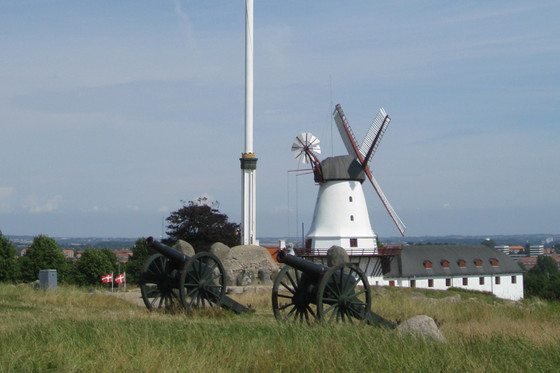Dybbøl mill - a Danish icon
We have many symbols in Denmark. But undeniably stands Dybbøl mill, as the greatest of all. The mill was the center of fierce fighting in the Schleswig wars in 1848-1849 and 1864. During the two wars, the mill was destroyed, but rebuilt. Dybbøl Mill was the epitome of the Danish resistance and endurance. And the mill still stands as the eternal national symbol - also in the border region.
Dybbøl mill was rebuilt four times
The mill was built for the first time in 1744. In 1800, proposed a lightning and was burned to the ground, however, set up immediately afterwards. In both Schleswig wars 1848-1850 and 1864, the mill was shot to pieces and rebuilt. 1848 organized the Danish military observation post in the mill. When the Danish and Prussian troops faced in the fighting on 5 June 1848 Dybbøl Mill was between them. On April 13, 1849, the mill burned during the fighting between the Danish troops and a Prussian army of 11,000 men.
The mill was rebuilt until 1853. 1864 created the Danish army back an observation post in Dybbøl mill. The use of the wing, it was possible to transmit signals to the Danish troops. The mill was constantly under attack and on 10 April, subject to the excess fire of the Prussian troops. The mill top and the wings are burned and the wave has crashed. 1864 suffered a defeat the Danes and the mill was a picture on the Danish Constitution - in the now lost land.
In 1914, the 50th anniversary of the defeat in 1864, the Icelandic priest Thordur Thomasson wrote a poem about Dybbøl mill:
Tvende Gange skudt i GrusAtter rejst som MøllehusVogter for et MindeboSelv en Bavta, dansk og tro.
Spejd så langt dit Øje nårGrav ved Grav i Marken står.Danske Mænd gav Livet henTroskab holder Skansen end.
Tåredugget ÆrekransSlaar om Dybbøls Navn sin Glans.Slægter dø, men Sproget binder.Fremtid gror af dyre Minder.
In 1935 the mill burned again - this time by a short circuit and was rebuilt in its present form. By 1990, the mill was operated by a number of tenants. The last tenant was Frede GREVSEN Petersen, who ran the mill from 1982 to 1990. 1995 was a museum of Sønderborg Castle Exhibitions in the granary and mill, which tells the story of Dybbøl as a national symbol and a reminder for two peoples - Denmark and Germany. www.museum-sonderjylland.dk/dybbol-molle.html
A. P. Moller and Mc-Kinney Møller Foundation Chastine general purpose give 5.5 million crowns for the restoration of the now derelict mill and in 2009, the mill was re-plastered and whitewashed, repaired the wings and the tour.
John Mogensen - a Danish singer and musician famous throughout Denmark with the song about Denmark and the Dybbøl mill. It was one of the contemporary protest songs, a hit among large segments of the population. All Danes knew what he meant when he presented mill protest the national symbol Dybbøl. But this song displeased politicians Erhard Jakobsen and his answer was: Dybbøl mill still grinds!
In 2014, we celebrated 150 years the Battle of Dybbøl mill with numerous commemorations. None other than the royal family and the prime minister traveled to Jutland to attend the celebrations. Around 15,000 people from Dybbol and Sønderborg came to be here on April 18. Danes and Germans stood shoulder to shoulder in the fortress, on stage and in the VIP tent. It was reminiscent of the fallen and the consequences of the war has been mentioned in many speeches. As the birthplace of the Danish society, which we know today and as a lever for the development of good cooperation on the German-Danish border.




